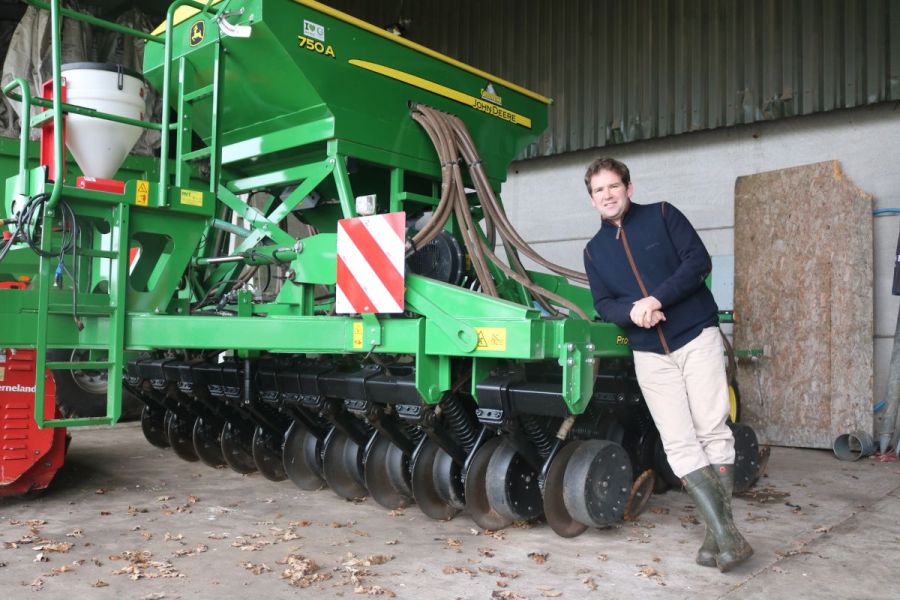Some of the UK’s most progressive pioneers in farming’s quest for net zero came together at CPM’s Climate Change Champions round table event in Kent, to discuss bringing it into mainstream farming, the benefits that accrue, and the urgency that it happens.
“The more we share what we learn, the faster we will get to net zero as an industry.”
By Tom Allen-Stevens
It’s time for all farmers to address the challenge of climate change, to drive forward the sustainability of their own business, and to help society progress towards net zero.
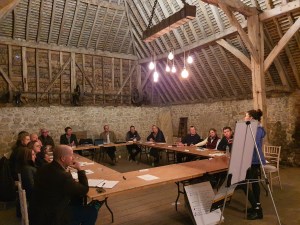
Eight champion farmers met with industry representatives and the NFU at Bank Farm, near Ashford, Kent, to discuss progress of the arable sector to net zero.
That was the resolve of the CPM Climate Change Champions who came together at a round table event in Kent last month with industry representatives and NFU deputy president Tom Bradshaw. The eight champion farmers, all of whom have comfortably reached net zero and are sequestering carbon in their soils, agreed that it takes commitment and a change of mindset to achieve this target, but there are “happy benefits” for those who take the journey.
Tom Bradshaw said it was “critical” that the drive for net zero moves into the mainstream. “The scale of the sustainability challenge is massive. We must help farmers position their businesses to meet this challenge, and get the full value from doing so.”
Michael Kavanagh, of DGF & MAM Thompson Farms, Shropshire, received the accolade of CPM Climate Change Champion 2022 (see panel on pxx). He spoke of the “happy consequence” of reducing costs, moving away from synthetic inputs and introducing grazed cover and companion crops. He now capitalises on his natural capital gains and completed his first carbon trade earlier this year.
“I’ve got the farm to where it is today through farmer-to-farmer learning, talking to other farmers, listening to them, sharing mistakes as well as successes. The more we share what we learn, the faster we will get to net zero as an industry,” he said.
Guy Eckley of Eckley Farms, Kent, underlined the importance of “the three free resources” – sunlight, water and air – in the production of healthy food that goes hand-in-hand with the drive to net zero.
“Cover crops capture the sunlight available after harvest and put sugars down into your soil; Soil structure is key to water-holding capacity. And that also helps the soil breathe, so that our underground biology is able to function and operate to the best of its ability.”
Tom Jewers of GD Jewers & Son, Suffolk, highlighted how “simple starts” on the journey to net zero include addressing fuel use, reducing cultivations and on-farm trials to find the “tipping point” beyond which lowering fertiliser usage starts to reduce yield. And he has novel plans for further fertiliser savings.
“Artificial intelligence will be the way forward. We want to get to a per-plant farming system where every single plant in the field can be tested for nutrient level and we can feed exactly what that plant needs.”
John Pawsey of Shimpling Park Farms, Suffolk, has doubled his soil organic matter (SOM) following a conversion to organic production 20 years ago. Critical to this are the sheep that graze the 2-3 year leys. The natural fertility he’s building in his soils has carbon benefits, and there’s now 20ha of agroforestry.
“Diversity of cropping is another way we can mitigate against extreme weather. We grow lots of novel bits and pieces but also lots of different winter and spring crops, which help us protect our business against any specific weather events and market risk.”
Robert Moore of Agricycle, Lincolnshire, has built a nationwide business around helping farmers recycle, and ties this to restoring biodiversity to the family farm.
“Over the past five years, we’ve set about reducing our reliance on mainstream services such as water and power. We’ve put solar panels on both rooves and field which provide two thirds of our power. And we’ve taken all the poorer ground out of production and put down 80ha of long-term leys,” he said.
Toby Hogsbjerg of The Wicken Farms Co, Norfolk, has set about securing a long-term future for the estate’s pivotal root crops from its fragile soils through cover crops, reduced cultivations and introducing livestock. “We have reduced fuel consumption, reduced hours giving staff better pay and more time at home through the different farming practices we have adopted,” he said.
“But every farm is different and we cannot all be measured on the same parameters and be deemed to fail if these don’t show the right results. We need more flexibility.”
Robin Aird of Charlton Park Farms, Wiltshire, bases his approach to the estate’s natural assets on a solid grasp of the underlying figures. He’s brought nitrogen applications from 210kgN/ha for a typical wheat crop to just 100kgN/ha through the use of digestate from the estate’s AD plant.
“Our approach has always been to keep the land in good heart, but we’ll sweat the estate’s assets, and ensure first and foremost that it’s a profitable business. That goes as much for its natural capital as it does for the crops we grow,” he said.
Carbon trade conundrum
So should you trade the carbon you sequester? Opinions among the champions were split. Along with Michael, 2020 champion John Hawkins of Bagber Farm, Dorset, has taken the step. “If somebody doesn’t make a start to get it off the ground, like you do when direct drilling, then it’ll never happen. And all of those large companies [looking for offsets] will walk away,” he said.
“Compared with the risk of putting an extra 50kgN/ha into a wheat crop to get an extra £20/t milling premium, I’d say it’s a reasonable risk to take.”
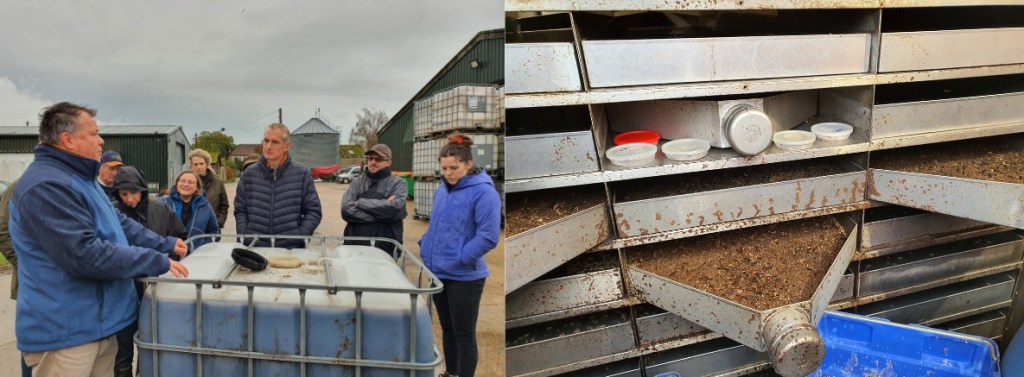
Host farmer Doug Wanstall (left) introduced the visiting farmers to nutrient-rich frass he’s been applying to crops and the black soldier fly larvae (right) that produce it.
Host farmer of the event, held at Bank Farm, near Ashford, and overall CPM champion of 2021 Doug Wanstall has helped set up the UK Carbon Code of Conduct (UKCCC). This is a central set of standards to help whole landholdings enter projects and benefit from restoring carbon.
“I would implore everybody to look very carefully at what you’re signing up to, and if it doesn’t adhere to the Taskforce on Scaling Voluntary Carbon Markets (TSVCM), don’t do it. Because someone will come and knock on your door and say they want their money back,” he advised.
John Pawsey also advised caution, noting “massive variability” in SOM analysis of samples from his fields, depending on place in the rotation and year.
Rutland farmer Sarah Bell views the carbon in her soils as part of the natural capital balance sheet and the carbon in the crops as the turnover. “But if I trade carbon, what am I trading and am I putting the assets of the business at risk?” she asked.
“It’s important to differentiate between insetting, where the carbon is traded within the same supply chain, and offsetting, where you trade it on the open market.”
Insetting is the route favoured by Tom Jewers, who believes carbon “should not be for sale” as it’s “morally wrong” to support a company that wishes to continue “pumping out oil”.
“Rather than buy the carbon, the company looking to offset should pay for the practice which generates that carbon sequestering. Nestlé have started doing this with farmers, which to me is something I feel more comfortable with.”
Sarra Mander of Small Robot Company also noted the opportunity. “Judging by the people we’re being approached by to accurately measure and record some of the metrics we’ve talked about, we feel there will be opportunities with the supply chain to sell produce you can guarantee has been produced in a sustainable way.”
Stalling on standards
Emma Ralph of Interagro voiced her frustration at a lack of common standards across the industry on how a carbon footprint is assessed, with “massive variances” with the three audits the business has undertaken.
“We need a joined-up approach on this not just for farmers but also on the manufacturing side. We do need some guidelines and there needs to be legislation. I want to be able to work with farmers to make sure they have the right information on carbon footprinting and at the moment, I’m not confident I can give that – it’s a potential issue for the whole agchem industry.”
Tom Bradshaw noted the added complication is that Emma’s business comes under Department for Business, Energy & Industrial Strategy (BEIS) while farming comes under Defra. When it comes to carbon calculators, he believes there needs to be better standardisation across the set of tools available to reduce variation, and allow farmers to understand their true footprint as accurately as possible. These developments will take time, he said, and in the short term encouraged farmers to choose the tool which best fits their operation in order to monitor and manage their operations’ emissions where possible.
Ben Makowiecki of Lloyds Bank doesn’t feel standardisation is likely to come from Defra. “But that’s not to say that the carbon calculators we’re already using aren’t useful. The most important thing is that businesses use a calculator to baseline their emissions . There are financial and environmental benefits for all parts of the farm business.”
Data deadlock
The digital divide threatens to slow the pace to net zero, warned Tom Bradshaw. “Decision-making must be underpinned by data, information has to be widely available and widely recorded to enable more farmers to make informed choices and reduce the footprint of the products they produce. Data will be critical to making this ambition a reality and enabling evidence-driven farming systems that other people can adopt.”
He said the NFU is keen for Defra to support farm businesses in understanding their carbon footprint, to help establish the industry baseline. This is especially important within the new ELM SFI scheme, where there are little actions so far to support monitoring and managing farm carbon footprints.
John Pawsey noted the value of a good, independent platform to record yield-mapping and crop quality data. “Data is increasingly important to display what is going on beneath the surface,” he said.
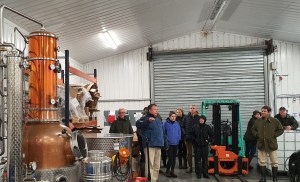
A vodka still at Bank Farm is a new diversification which complements the other biobased enterprises.
But he pointed out the “massive amount of information you have to bring together” for an accurate carbon calculation, and that time-poor farmers have little time or appetite for it, once they’ve completed Red Tractor and other paperwork. “Even if you get a free audit, it’s never free because you have to invest a huge amount of time and put in all the information. This is a big bit of work,” he said.
Summing up, Tom Bradshaw noted that “the sustainability agenda and the pressure coming there is like I have never known and it’s not going away. Farmers must be on the front foot to make sure they gain their fair reward for the good work they do.
“With a population increasingly live to the risks of climate change, carbon will likely be an ever more important factor in markets moving forwards, and farmers will need to move with demand while continuing to supply the market place with the same high quality food consumers can trust – not a small task but I know our industry can rise to the challenge” Tom stated.
How to capitalise on climate change opportunities
An afternoon workshop at the CPM round table event brought together the champion farmers and other attendees to explore ways arable farming could accelerate the pace towards net zero and the positive changes growers and the industry could take.
Splitting into three groups, they discussed:
- Productivity push – with a key focus on nutrient use efficiency (NUE)
- Cultivation care – sequestering soil carbon with confidence
- Biobased boldness – societal benefits beyond carbon
Ideas came together in three categories:
- Now – represents unoriginal ideas which are familiar, easy to implement, and proven to work well.
- Wow – represents new ideas that are easy to implement and executable ideas that can be actualised.
- How – represents ideas that are innovative, but difficult to implement so they are not yet feasible, but might be worth considering as future goals.
Attendees then decided on the Three Big Ideas that would bring the boldest opportunities for farming as well as the biggest benefits for society.
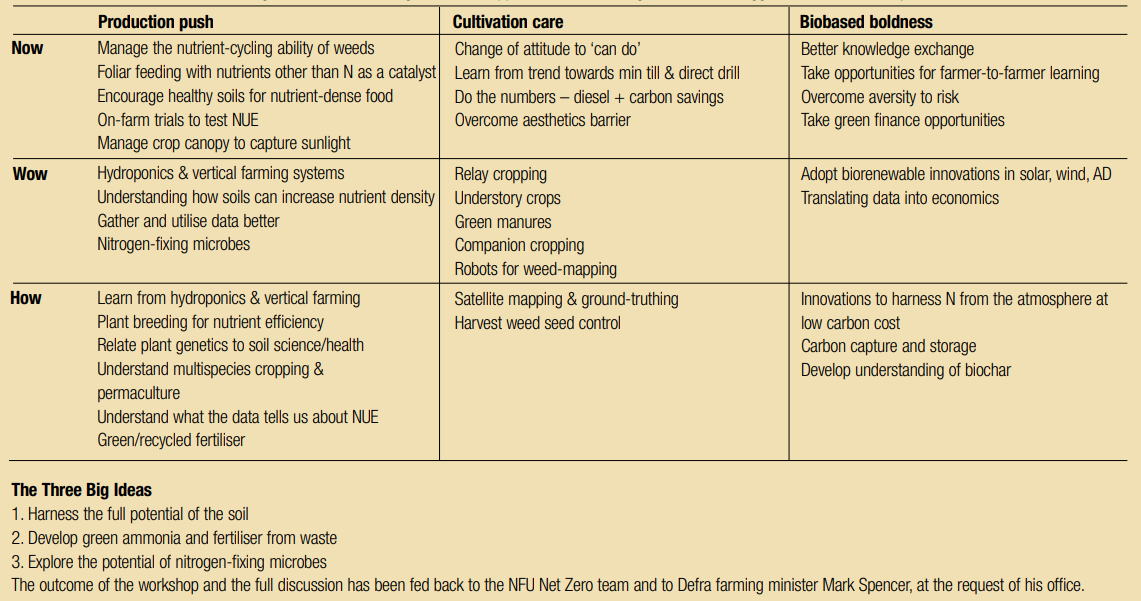
Climate Change Champions supports the NFU’s bold ambition for agriculture to achieve net zero emissions by 2040. CPM would like to thank our sponsors, leading agricultural suppliers who have a credible net zero aspiration and are working with farmers in a partnership approach to meet this challenging target.



This article was taken from the latest issue of CPM. For more articles like this, subscribe here.

